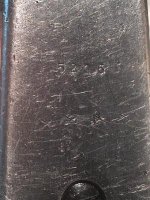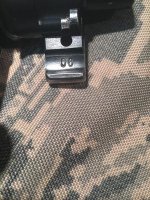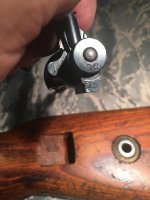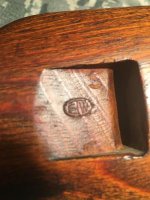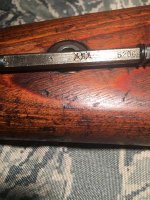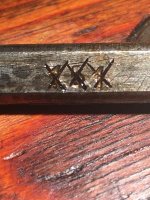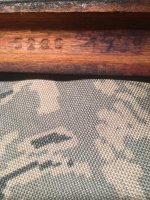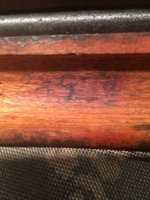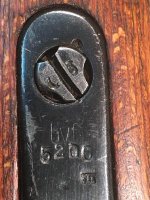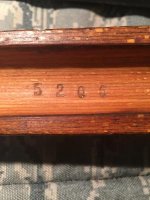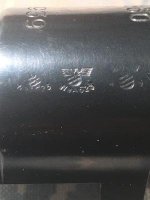I've reached out to many sources and asked opinions of many "experts" regarding an inherited k98. The responses have been drastically different leading me to believe many in the market are unscrupulous...but on the positive side, I'm learning a lot as I go along. On my 1939 Steyr (code 660) the serial numbers on the barrel, receiver, bolt handle, firing pin, butt plate and stock are all matching. The last two digits of the serial number are stamped on the safety, cocking piece and bolt sleeve. My rifle was purchased from an army surplus store in the late 1950's and remained in the family safe for over 60 years so no one has messed with it. Was the K98 market in the 50's such that someone would have gone through the trouble to acquire unmarked parts and stamped them to match? (I doubt this scenario as my father bought the rifle for less than $50 at the time) If it is a post war refurb as speculated by some, would whomever have stamped numbers onto all the parts or have just refinished the rifle? Is it normal for a rifle of this period to just have the last two numbers of the serial stamped onto the smaller pieces or is that a post war practice? Another puzzling feature is the trigger guard does not have the capture screw cut out yet it is clearly stamped with the correct serial number? Wouldn't a rifle of this vintage been originally equipped with the capture screw trigger guard/housing?

You are using an out of date browser. It may not display this or other websites correctly.
You should upgrade or use an alternative browser.
You should upgrade or use an alternative browser.
When did fake k98's start appearing?
- Thread starter pypes
- Start date
mto7464
Senior Member
you need to post pics of the rifle.
Can't really say myself on the fakery. i doubt back then it was being done. I am sure it started with high end stuff first like lugers. I am thinking more toward the 70's when it started. But that is just a guess. I collected medals and german badges back then and there were fakes already of them.
Also the rifle that has been in the family for 60 years is hard to prove and say for sure and sometimes memories are clouded. Pictures ofit will say a lot.
Can't really say myself on the fakery. i doubt back then it was being done. I am sure it started with high end stuff first like lugers. I am thinking more toward the 70's when it started. But that is just a guess. I collected medals and german badges back then and there were fakes already of them.
Also the rifle that has been in the family for 60 years is hard to prove and say for sure and sometimes memories are clouded. Pictures ofit will say a lot.
Bob in OHIO
Senior Member
The “last two” digits of the serial on the safety etc.... is a red flag for an original factory numbered rifle. A few pics would help the effort here
Zeppelin5000
Senior Member
I've reached out to many sources and asked opinions of many "experts" regarding an inherited k98. The responses have been drastically different leading me to believe many in the market are unscrupulous...but on the positive side, I'm learning a lot as I go along. On my 1939 Steyr (code 660) the serial numbers on the barrel, receiver, bolt handle, firing pin, butt plate and stock are all matching. The last two digits of the serial number are stamped on the safety, cocking piece and bolt sleeve. My rifle was purchased from an army surplus store in the late 1950's and remained in the family safe for over 60 years so no one has messed with it. Was the K98 market in the 50's such that someone would have gone through the trouble to acquire unmarked parts and stamped them to match? (I doubt this scenario as my father bought the rifle for less than $50 at the time) If it is a post war refurb as speculated by some, would whomever have stamped numbers onto all the parts or have just refinished the rifle? Is it normal for a rifle of this period to just have the last two numbers of the serial stamped onto the smaller pieces or is that a post war practice? Another puzzling feature is the trigger guard does not have the capture screw cut out yet it is clearly stamped with the correct serial number? Wouldn't a rifle of this vintage been originally equipped with the capture screw trigger guard/housing?
We would need to see photos, but even in the 50's things could have been done to the rifle. Not necessarily to fool someone, but for other reasons such as someone just wanting to change a part due to damage. Back then, I don't believe there really was any monetary gain on faking markings. To answer a couple questions, yes, on a rifle such as yours, it was normal to only use the last two digits on smaller parts, but I believe safeties had all numbers. Does the trigger guard itself have a correct serial number, or just the floor plate? A 1939 rifle should have the lock screws from factory. Again, post photos if you can for a proper assessment.
Last edited:
I've reached out to many sources and asked opinions of many "experts" regarding an inherited k98. The responses have been drastically different leading me to believe many in the market are unscrupulous...but on the positive side, I'm learning a lot as I go along. On my 1939 Steyr (code 660) the serial numbers on the barrel, receiver, bolt handle, firing pin, butt plate and stock are all matching. The last two digits of the serial number are stamped on the safety, cocking piece and bolt sleeve. My rifle was purchased from an army surplus store in the late 1950's and remained in the family safe for over 60 years so no one has messed with it. Was the K98 market in the 50's such that someone would have gone through the trouble to acquire unmarked parts and stamped them to match? (I doubt this scenario as my father bought the rifle for less than $50 at the time) If it is a post war refurb as speculated by some, would whomever have stamped numbers onto all the parts or have just refinished the rifle? Is it normal for a rifle of this period to just have the last two numbers of the serial stamped onto the smaller pieces or is that a post war practice? Another puzzling feature is the trigger guard does not have the capture screw cut out yet it is clearly stamped with the correct serial number? Wouldn't a rifle of this vintage been originally equipped with the capture screw trigger guard/housing?
The internets and forums are filled with bullshit from people who don't know what they don't know, are just engaged in self-important asstalk without much of a real clue, and/or who are shilling for someone. With respect to K98ks, you can trust the information you get here as the final word over all other forums concerning this subject matter. Period. We don't censor and all information here is vetted by the foremost authorities on the subject matter on this planet.
K98ks have been renumbered and faked as long as I've been involved in the hobby, i.e., since about 1981 as a kid. Your remaining inquiries cannot be answered intelligently without good pics of the areas of your concerns.
Cheers,
HB
Intruder196
Senior Member
Once somebody realizes a buck can be made, fakery begins. Even if fakery is as simple as some BS story about "pop picked this up from Hitler/Hermann Goring or name-your-most-recognizable-Nazi" and attach said story to said rifle to fetch a premium. And that has probably gone on since the end of WW2.
Warrior1354
ax - hole
I agree with hambone on that I think k98k really started getting enhanced and faked around the late 70s early 80s. If you look back in the fifties and sixties the high prize German World War II firearm was a Luger. I laugh when I joke with the older collectors and they tell me back in the day the P-38 was considered the poor man's Luger.
If you want to look at the really fake stuff anything related to the SS or SA. There were fake SA daggers coming out of Spain in 1946.
If you want to look at the really fake stuff anything related to the SS or SA. There were fake SA daggers coming out of Spain in 1946.
One possibility that I haven’t seen mentioned is perhaps it was reworked DURING the war, a rifle built in 1939 could certainly have been worn to the point repairs were needed. Parts numbered with 2 digits is common on wartime depot repairs. But, as others stated, pictures are needed to determine if it’s wartime done. Usually stocks will show markings related to the work.
Sent from my iPhone using Tapatalk
Sent from my iPhone using Tapatalk
Warrior1354
ax - hole
One possibility that I haven’t seen mentioned is perhaps it was reworked DURING the war, a rifle built in 1939 could certainly have been worn to the point repairs were needed. Parts numbered with 2 digits is common on wartime depot repairs. But, as others stated, pictures are needed to determine if it’s wartime done. Usually stocks will show markings related to the work.
Sent from my iPhone using Tapatalk
Very good point Mike that would 100% be a possibility but without pictures I can't say. To the OP please post pictures and we should be able to tell you more.
One possibility that I haven’t seen mentioned is perhaps it was reworked DURING the war, a rifle built in 1939 could certainly have been worn to the point repairs were needed. Parts numbered with 2 digits is common on wartime depot repairs. But, as others stated, pictures are needed to determine if it’s wartime done. Usually stocks will show markings related to the work.
Sent from my iPhone using Tapatalk
Yes, I was going to mention this. Could be a depot repair which is why some say fake. Many, if not most, collectors don't understand depot repairs (especially Luger collectors). Please post pictures. As Hambone said, this is the place to ask. There is no better place.
I agree with what has been said. As long as money can be made, faking has been happening. As I recall, I have read that even in 1945 there were fakes coming out of Germany--the demand was high among the occupation troops for souvenirs--so some of the German makers kept making stuff--like daggers, medals, etc. (which was illegal), and sold it to the GI's as original. I think there were "warehouse finds" of iron crosses and such up until the 60's.
I would guess that a fake iron cross or dagger made in Germany by the same workers with the same equipment and materials after the surrender in 1945 would probably be considered original today. How many fakes are out there that are considered original today? No way to know because they are "real".
However--I don't know that daggers were actually made by the Nazi's in 1945...So I may be wrong about fake daggers coming out in 1945--but I have read that was the case.
I would guess that a fake iron cross or dagger made in Germany by the same workers with the same equipment and materials after the surrender in 1945 would probably be considered original today. How many fakes are out there that are considered original today? No way to know because they are "real".
However--I don't know that daggers were actually made by the Nazi's in 1945...So I may be wrong about fake daggers coming out in 1945--but I have read that was the case.
View attachment 241567
View attachment 241568
View attachment 241569
View attachment 241570
View attachment 241571
View attachment 241572
View attachment 241573
View attachment 241574
View attachment 241575
View attachment 241576
View attachment 241577
View attachment 241578
View attachment 241579
View attachment 241580
View attachment 241581
View attachment 241582
View attachment 241583
View attachment 241584
Starting to think RC?
Way to nice for a rc, looks like a post war refurb to me. As to what country you got me.
Agree, a post war refurbished rifle. It’s not uncommon to see these, and using the word fake attached to it is wrong. I’ve never seen some of these traits, but the ETW stamp in the wood is probably a good clue to start with. I suspect it’s post war German though, the numbering is too “German” not to be.
Sent from my iPhone using Tapatalk
Sent from my iPhone using Tapatalk



